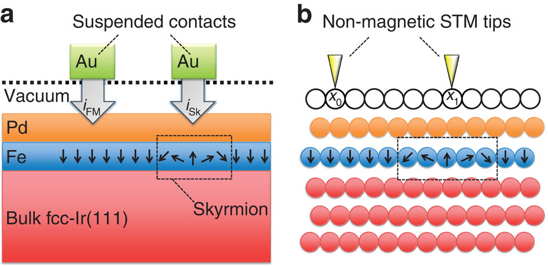R&D: Perpendicular Reading of Single Confined Magnetic Skyrmions
Pin-mixing magnetoresistance could possibly be incorporated in future magnetic storage technologies.
This is a Press Release edited by StorageNewsletter.com on October 20, 2015 at 3:15 pmNature Communications has published an article written by Dax M. Crum, Microelectronics Research Center, The University of Texas at Austin, 10100 Burnet Road, Austin, Texas 78758, USA, and Peter Grünberg Institut and Institute for Advanced Simulation, Forschungszentrum Jülich and JARA, D-52425 Jülich, Germany, Mohammed Bouhassoune, Juba Bouaziz, Benedikt Schweflinghaus, Stefan Blügel, and Samir Lounis, Peter Grünberg Institut and Institute for Advanced Simulation, Forschungszentrum Jülich and JARA, D-52425 Jülich, Germany.
(a) Illustrative heterostructure cross-section for the perpendicular reading
of single nanoskyrmions. Due to energy-dependent spin-mixing perturbations
to the atomistic electronic structure as a function of position within skyrmions, the electric current relation iFM≠iSk holds, and therefore the magnetic data information can be sensed in a CPP-geometry. (b) Illustrative STM-spectroscopy experiment of fcc-Pd/Fe overlayer on single-crystal fcc-Ir(111) bulk substrate. The tunneling conductance is modified by the combined effects of local magnetic noncollinearity and substrate-induced spin–orbit interaction. For similar physical reasons as a, the tunnelling conductance at position x0 is different from that at position x1.
Abstract : “Thin-film sub-5 nm magnetic skyrmions constitute an ultimate scaling alternative for future digital data storage. Skyrmions are robust noncollinear spin textures that can be moved and manipulated by small electrical currents. Here we show here a technique to detect isolated nanoskyrmions with a current perpendicular-to-plane geometry, which has immediate implications for device concepts. We explore the physics behind such a mechanism by studying the atomistic electronic structure of the magnetic quasiparticles. We investigate from first principles how the isolated skyrmion local-density-of-states which tunnels into the vacuum, when compared with the ferromagnetic background, is modified by the site-dependent spin mixing of electronic states with different relative canting angles. Local transport properties are sensitive to this effect, as we report an atomistic conductance anisotropy of up to ~20% for magnetic skyrmions in Pd/Fe/Ir(111) thin films. In single skyrmions, engineering this spin-mixing magnetoresistance could possibly be incorporated in future magnetic storage technologies.“
Read also:
NIST and UC Davis Scientists Float New Approach to Creating Computer Memory
Brings skyrmions step closer for use in real-world storage as well as other novel magnetic and electronic technologies.















 Subscribe to our free daily newsletter
Subscribe to our free daily newsletter

